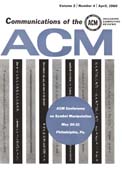April 1960 - Vol. 3 No. 4

Features
Syntactic and semantic augments to ALGOL
The purpose of this paper is to propose a set of syntactic and semantic augments to ALGOL. The proposed extension are designed to facilitate the description of “string” manipulation in that language; they do not constitute a comprehensive language for symbol manipulation. Several such languages (LISP, IPL, …) already exist—many more will be designed and advantageously used in the future. It is felt that such languages belong in the repertoire of some language-system which contains a hierarchy of languages as well as nested “continua” of languages. In such systems, new languages may be embedded, appended, extracted at will. The fact that ALGOL is, implicitly, such a language-system seems to be only dimly recognized, even by designers. In any event, what is proposed in the sequel is not a language for symbol manipulation—qua language; but rather, a set of obvious extensions to the “algebraic-language” portion of ALGOL. To be sure, these extensions are complete in the sense that they are sufficient to describe symbol manipulations, but after all, the same statement holds for machine-language. Moreover, the extensions do not constitute a minimal set of primitives for string or symbol manipulations—in the sense that complementation, shifting, … are primitives for machine arithmetic. Such primitives are essential only to machine designers (including designers of “augmented machine”, the basic machine augmented by subroutines for arithmetics not included in the hardware); to append only such primitives to ALGOL is to visit the omissive sins of the machine designers upon the users of ALGOL.
Macro instruction extensions of compiler languages
Macroinstruction compilers constructed from a small set of functions can be made extremely powerful. In particular, conditional assembly, nested definitions, and parenthetical notation serve to make a compiler capable of accepting very general extensions to its ground language.
Decoding combinations of the first n integers taken k at a time
The following problem arose in connection with some studies involving game programming: the representation of any position in the game tree was formed by a sequence of k different integers selected from the first n integers. It was desired to decode any of these representations to a unique memory address such that all such addresses formed a compact group in the memory. Mathematically, the problem was to find a transformation of the representation such that any of the n!/(n - k)! sequences transformed uniquely to one of the set of integers from 0 to [n!/(n - k)! - 1]. A procedure for this is described here.
A control system for logical block diagnosis with data loading
This paper describes a section of an integrated diagnostic monitor system which facilitates the checking of sections of instructions or subroutines anywhere in the object program. A new method of specifying all diagnostic operations in a format similar to a computer program makes the system convenient to use and relatively simple to understand. The paper also describes a number of other novel diagnostic features which can be included in the system.
For centuries the decimal number system reigned supreme, except, perhaps, among the Mayan Indians, until the advent of digital computers brought the binary and octal systems into the limelight. This paper introduces another number system which may prove useful for manipulating complex numbers on machines.



